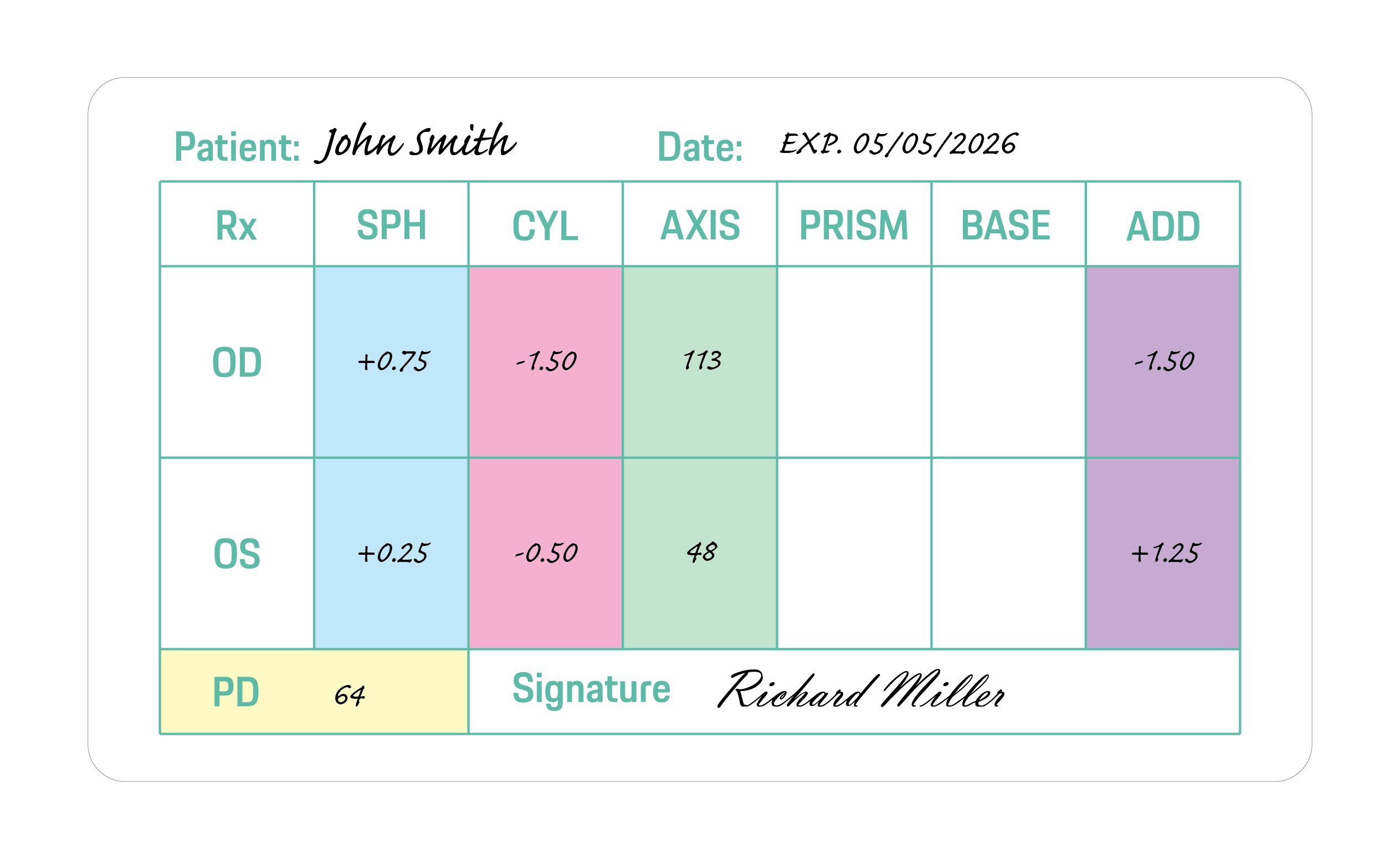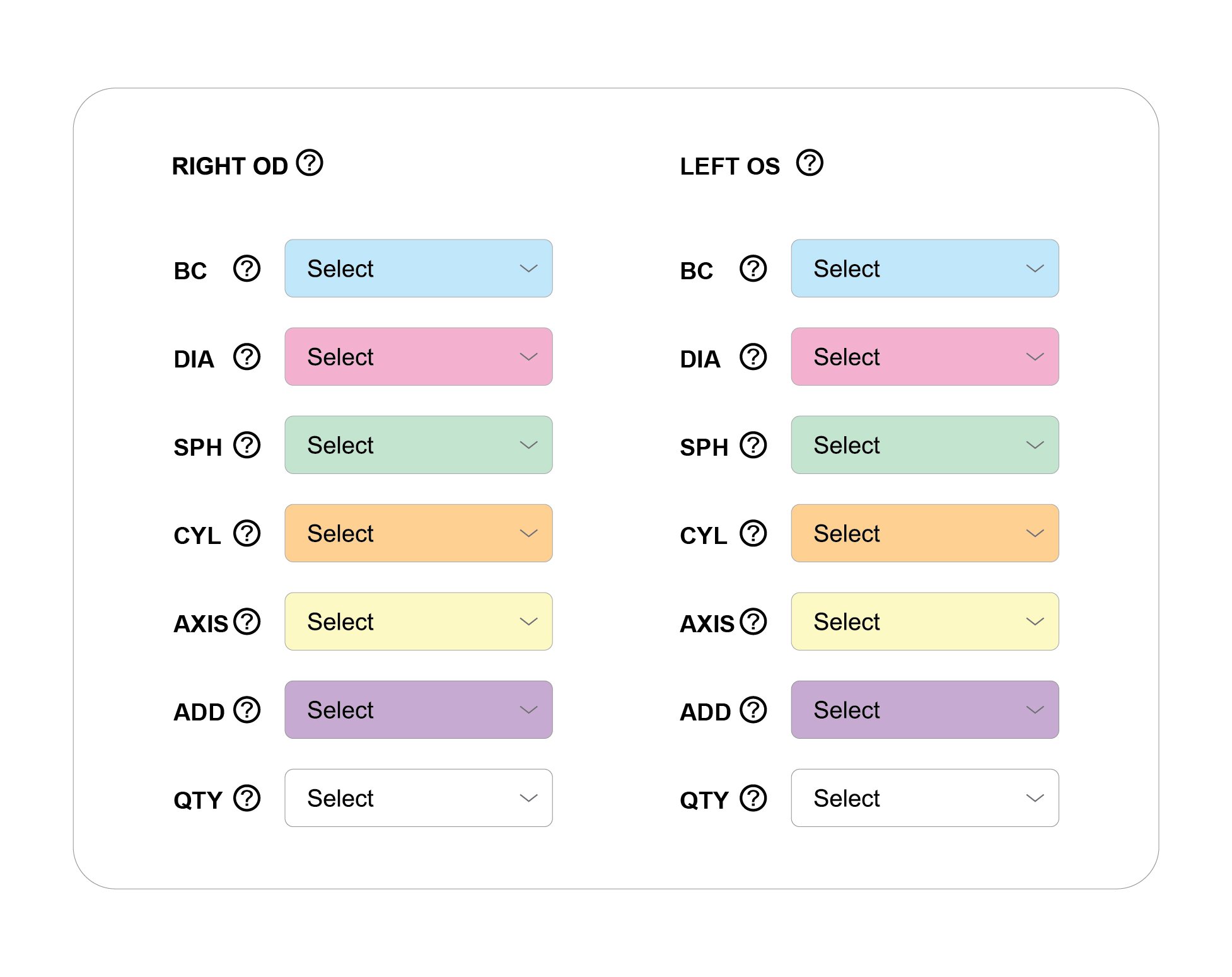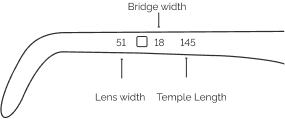
Welcome back!
Ready to check out?
You're just one click away from fantastic style and even better savings!


OD is an abbreviation for the Latin term oculus dexter which means right eye. Notice that the right eye information is asked for first even though we typically read from left to right.
OS is an abbreviation of the Latin oculus sinister which means left eye. That will be referenced on the far right column of the prescription.
SPH is short for sphere. The sphere of your prescription indicates the power on the lenses that is needed to see clearly. A plus (+) symbol indicates the eyeglass wearer is farsighted. A minus (-) symbol indicates that the eyeglass wearer is nearsighted.
CYL is short for cylinder. The cylinder indicates the lens power necessary to correct astigmatism. If the column has no value (is blank), it indicates that the eyeglass wearer does not have astigmatism. If this is the case on your prescription, you can leave it blank when entering it in.
AXIS is a prescription will include an axis value for those with astigmatism. This number represents the angle of the lens that shouldn't feature a cylinder power to help correct your astigmatism.
ADD is short for "additional correction." This is where details about bifocals, multifocal lenses or progressive lenses would appear.


OD is an abbreviation for the Latin term oculus dexter which means right eye. Notice that the right eye information is asked for first even though we typically read from left to right.
OS is an abbreviation of the Latin oculus sinister which means left eye. That will be referenced on the far right column of the prescription.
B.C. is short for base curve measurement indicates the back curvature of your contact lens, in millimetres. This is important for comfort, as the BC of your contact lenses should match your eye's natural curve as closely as possible to ensure a better fit when you are wearing your contact lenses.
DIA is short for "diameter," or the distance from one edge of the contact lens to the other. This is measured in millimeters.
SPH is short for sphere. The sphere of your prescription indicates the power on the lenses that is needed to see clearly. A plus (+) symbol indicates the eyeglass wearer is farsighted. A minus (-) symbol indicates that the eyeglass wearer is nearsighted.
CYL is short for cylinder. The cylinder indicates the lens power necessary to correct astigmatism. If the column has no value (is blank), it indicates that the eyeglass wearer does not have astigmatism. If this is the case on your prescription, you can leave it blank when entering it in.
AXIS is a prescription will include an axis value for those with astigmatism. This number represents the angle of the lens that shouldn't feature a cylinder power to help correct your astigmatism.
ADD is short for "additional correction." This is where details about bifocals, multifocal lenses or progressive lenses would appear.
*Discount applied on the current website price at the time of order. Offer only valid for new customer first contacts order over $10. Maximum discount of $100. Cannot be combined with any other offers. Promotions are subject to change without notice. We reserve the right to cancel orders that are in breach of the terms and conditions of this offer.











| Lens Width | Bridge Width | Temple Length | |
|---|---|---|---|
| XS | < 42 mm | < 16 mm | <=128 mm |
| S | 42 mm - 48 mm | 16 mm - 17 mm | 128 mm - 134 mm |
| M | 49 mm - 52 mm | 18 mm - 19 mm | 135 mm - 141 mm |
| L | >52 mm | >19 mm | >= 141 mm |
Check the measurements on your current frames. The numbers found on the inside of the temple will be the eye size (lens width), followed by the bridge size, then the temple length. You can then order any frames that are around the same size.
If you try on glasses at a store, write the numbers down for reference.
There are a few factors that will affect this. The most important will be your face shape. Check the image above to see which you might be. You can also consult with one of our friendly staff. He or she will help you select frames that look best with your facial shape.Once you are happy with a style, you will want to find a frame color that compliments your skin tone.
The bottom line is that you must like your glasses. Only select a pair that you are comfortable with and you feel compliments your looks. We, at Kits.ca want you to love your eyeglasses.
 Rectangular
Rectangular
Round frames are good for softening the lines of a square face.
 Oval
Oval
If you have an oval face, consider yourself fortunate: almost any fame should suit your face.
 Round
Round
If you have a round face, a square shape looks great and minimizes roundness.
 Heart
Heart
If you have a heart-shaped face, choose frames with low temples and lenses that get wider at the bottom. This will add fullness over the lower half of your face.
 Triangular
Triangular
People of triangular faces, with their wide jaw lines, are complimented by cat's eye shapes.
Sometimes the hardest part about buying new glasses is choosing a frame style to suit your face. Experts say the best thing to keep in mind is to "think opposite". Try frames that are reverse shape of your face and see what they do for you. It's likely they will flatter you.
If you still need help answer a question or have another inquiry just call or email us! You can also use our Live Chat feature to reach a representative.